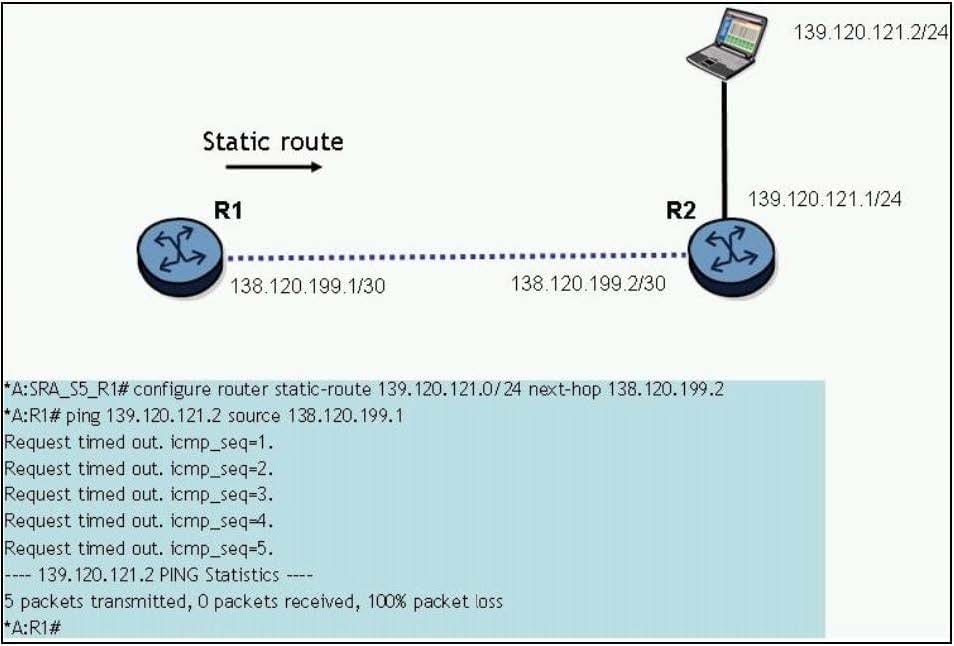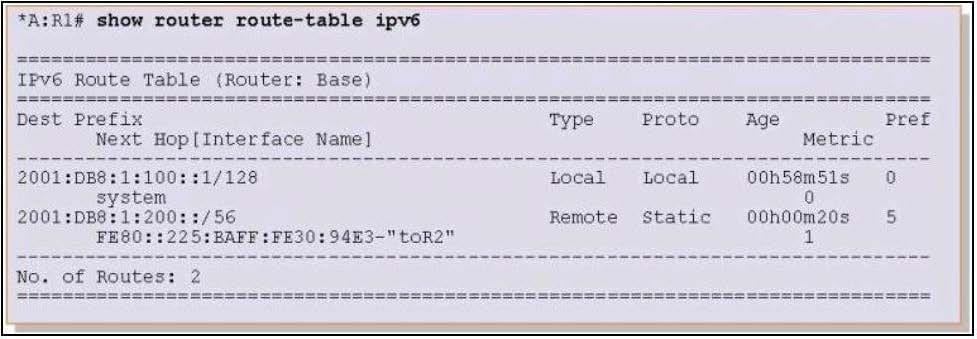Exam Details
Exam Code
:4A0-101Exam Name
:Nokia Interior Routing ProtocolsCertification
:Nokia CertificationsVendor
:NokiaTotal Questions
:315 Q&AsLast Updated
:Apr 16, 2025
Nokia Nokia Certifications 4A0-101 Questions & Answers
-
Question 171:
Click the exhibit button.

Router 2 advertises the network 192.168.3.0/24 to router R1 via IS-IS. How can router R1 ensure that it discards the route?
A. Use a prefix list on router R1 to discard all ingress IS-IS routes.
B. Use an export policy and prefix list on router R1.
C. Use an import policy and a prefix list on router R1.
D. This is not possible because IS-IS cannot use import policies.
-
Question 172:
A router sets the E bit in the flags of its Type 1 LSA. What does this indicate?
A. The router is an ABR.
B. The router is an ASBR.
C. The router is at the end of a virtual link.
D. The router's interface is in a stub area.
-
Question 173:
Which of the following describes the method used to resolve an IPv6 address to a MAC address?
A. IPv6 uses the Address Resolution Protocol to resolve the address to a MAC address.
B. A Neighbor Discovery message is sent to the broadcast MAC address. The host with the IPv6 address responds with a Neighbor Advertisement message.
C. A Neighbor Discovery message is sent to the solicited-node multicast address. The host with the IPv6 address responds with a Neighbor Advertisement message.
D. A Neighbor Discovery message is sent to the anycast address for the LAN. The host with the IPv6 address responds with a Neighbor Advertisement message.
E. IPv6 addresses do not need to be resolved to a MAC address.
-
Question 174:
Which of the following statements regarding IS-IS DIS is false?
A. L1 and L2 routers elect separate DIS's.
B. DIS uses multicast address 0180x200:0015 to communicate with other routers on the broadcast network.
C. If a new router starts up in a LAN and has a higher interface priority, the new router preempts the original DIS and becomes the DIS.
D. In broadcast multi-access networks, such as Ethernet, a single router is elected as the DIS. There is no backup DIS
-
Question 175:
Refer to the exhibit below.

R1 distributes its loopbacks into IS-IS and globally routed addresses are configured as shown. How many routes will R4 have in its IPv6 route table?
A. 1
B. 2
C. 3
D. 4
E. 6
F. 7
-
Question 176:
Which three IS-IS PDU types are used for database synchronization?
A. Hellos, CSNPs, PSNPs
B. LSPs. Hellos, CSNPs
C. LSPs, PSNPs, Hellos
D. LSPs, CSNPs, PSNPs
-
Question 177:
Which of the statements below best describes the operation of the IPv6 anycast address?
A. A packet with a destination anycast address is sent to all nodes on the local link.
B. A packet with a destination anycast address is sent to all nodes on the local network.
C. A packet with a destination anycast address is sent to all nodes that have joined the anycast group.
D. A packet with a destination anycast address is sent to the nearest node that is assigned the anycast address
E. A packet with a destination anycast address is sent to all nodes that are assigned the anycast address.
-
Question 178:
Click the exhibit button.

A static route has been configured on router R1 to reach the PC at 139.120.121.2. However, as shown in the exhibit, the ping fails. What is the most likely cause of the problem?
A. Router R2 does not have a route to the system address of router R1 and therefore cannot respond to the ping.
B. There is no default route configured on the PC.
C. Router R2 does not have a route configured to the PC.
D. Router R1 needs to be configured with a default route.
-
Question 179:
What is the CIDR summary for the block of networks from 193.4532.0/24 to 193.45.47.0/24?
A. 193.45 32 0/20
B. 193.45.0.0/21
C. 192.45.32.0/21
D. 192.45.0.0/20
-
Question 180:
The exhibit shows a route to 2001:DB8:1:200::/56 in the IPv6 route table. How did the route get into the route table?

A. Configure router ipv6 static-route 2001:DB8:1:200::/56 next-hop FE80::225:BAFF:FE30:94E3
B. Configure router ipv6 static-route 2001:DB8:1:200::/56 next-hop FE80::225:BAFF:FE30:94E3-toR2
C. Configure router static-route 2001:DB8:1:200::/56 next-hop FE80::225:BAFF:FE30:94E3
D. Configure router static-route 2001:DB8:1:200::/56 next-hop FE80::225:BAFF:FE30:94E3- toR2
E. The route was learned through a dynamic routing protocol.
Related Exams:
4A0-100
Nokia IP Networks and Services Fundamentals4A0-101
Nokia Interior Routing Protocols4A0-102
Nokia Border Gateway Protocol for Internet Routing4A0-103
Nokia Multiprotocol Label Switching4A0-104
Nokia Services Architecture4A0-105
Nokia Virtual Private LAN Services4A0-106
Nokia Virtual Private Routed Networks4A0-107
Nokia Quality of Service4A0-108
Nokia Multicast Protocols4A0-109
Alcatel-Lucent Triple Play Services
Tips on How to Prepare for the Exams
Nowadays, the certification exams become more and more important and required by more and more enterprises when applying for a job. But how to prepare for the exam effectively? How to prepare for the exam in a short time with less efforts? How to get a ideal result and how to find the most reliable resources? Here on Vcedump.com, you will find all the answers. Vcedump.com provide not only Nokia exam questions, answers and explanations but also complete assistance on your exam preparation and certification application. If you are confused on your 4A0-101 exam preparations and Nokia certification application, do not hesitate to visit our Vcedump.com to find your solutions here.